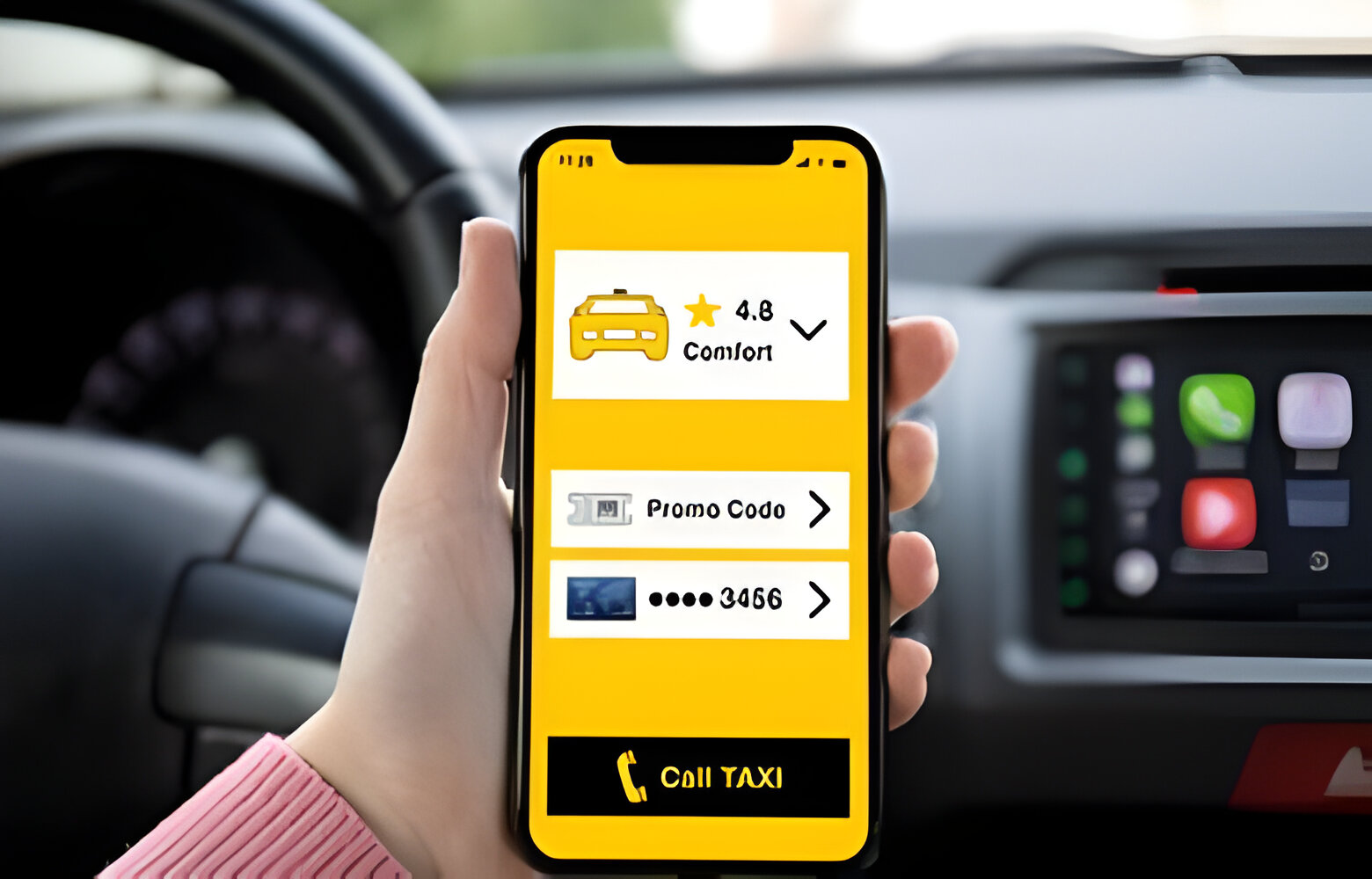Have you noticed how the days of standing on a street corner, hoping for a taxi, have faded into the past? Thanks to the rise of taxi booking apps, getting a ride is now as easy as a few taps on your smartphone.
If you’re looking for fresh and profitable taxi app development ideas, you’re in the right place. The global market for ride-hailing services is booming, with projections indicating it could reach a staggering $165.60 billion by the end of 2024. This growth spans across developing economies like India, China, and Vietnam, as well as established markets such as the United States, Canada, and various European countries.
The success of these apps has spurred the creation of numerous taxi-booking app development companies. These companies are continuously innovating, introducing services ranging from carpooling solutions to specialized options like women-friendly taxis and healthcare transport services.
As the industry continues to evolve, new features are constantly being integrated into these apps to enhance user experiences and broaden service offerings. This ongoing evolution ensures that taxi apps remain indispensable in modern urban mobility.
Eager to explore the top 15 innovative taxi app development ideas poised to make waves in 2024? Let’s delve into them.
15 Highly Profitable Taxi App Development Ideas to Consider in 2024
Here’s a comprehensive look at the top 15 innovative taxi app development ideas you should explore:
1. Women-friendly Taxis
Looking to launch a taxi service? Consider women-friendly taxis as a niche market.
Safety for women travelers remains a significant concern globally. Offering dedicated women-friendly taxis can address this issue effectively. With nearly half of the world’s population being female, there is a substantial potential market.
Several cities across various regions, including India, South Africa, the Middle East, and the US, have already introduced initiatives for women-friendly transport. Despite current initiatives, there’s still a growing demand due to the limited availability of women drivers in the industry, making this a promising opportunity for growth.
2. Healthcare Taxi Services
The COVID-19 pandemic underscored the need for reliable healthcare transport services. Some taxi companies have adapted by offering specialized healthcare transportation, which proved essential during the crisis.
Beyond the pandemic, there remains a steady demand for healthcare taxi services, particularly for transporting elderly or medically fragile individuals who require regular medical appointments or emergency care.
Partnering with hospitals and healthcare facilities can enhance the visibility and credibility of your app, ensuring it meets stringent healthcare standards.
3. Bike Taxi Services
In urban areas, commuting can be a challenge, especially with congestion and limited parking. Bike taxis offer a convenient, cost-effective alternative for short to medium distances.
Compared to traditional cars, bikes navigate traffic more efficiently, reducing travel time and costs for users. Investing in a bike taxi app can tap into the growing demand for flexible, eco-friendly transportation solutions in cities worldwide.
4. Carpooling Taxi Services
Carpooling continues to gain popularity for its affordability and environmental benefits. By enabling users to share rides, carpooling reduces individual transportation costs and contributes to reducing traffic congestion and emissions.
Integrating carpooling features into your taxi app can attract budget-conscious travelers and environmentally-conscious commuters alike, enhancing user engagement and service utilization.
5. Shuttle Transportation Services
For daily urban commuters, shuttle services provide a reliable and cost-effective transportation solution. These app-based services offer convenient pickup and drop-off options, catering to the needs of commuters traveling to work, school, or other regular destinations.
By offering reliable scheduling, affordable rates, and environmentally friendly options, shuttle transportation apps can become indispensable in urban mobility solutions.
6. Delivery Services
The traditional courier system, with its uncertainties and delays, has evolved significantly with the advent of on-demand courier applications. These apps have streamlined the delivery process, allowing users to send parcels, important documents, and even home-cooked meals with ease, all from their smartphones. Launching a delivery service app can capitalize on this convenience trend, catering to a wide range of delivery needs efficiently.
7. Luxury Vehicle Renting Apps
While not everyone owns a luxury vehicle, there is a substantial demand for renting it, especially for special occasions like weddings, business meetings, or airport pickups. Luxury vehicle renting apps cater to this demand by providing access to premium cars that leave a lasting impression. This niche market ensures continuous demand, making it a lucrative option for taxi app development.
8. Eco-friendly Taxis
With increasing environmental awareness, there is a growing preference for eco-friendly transportation options. Offering eco-friendly taxis can attract environmentally conscious customers who prioritize sustainability in their daily choices. As platforms like Uber aim for zero-emission fleets by 2040, investing in eco-friendly transport services presents a promising future despite initial costs. This niche appeals to a large user base seeking affordable and environmentally friendly ride options.
9. Chauffeur Services
Chauffeur services cater to individuals who prefer the luxury and convenience of having a personal driver. This service is particularly appealing to those who may own a vehicle but prefer not to drive themselves or are learning to drive. By offering chauffeur-driven rides through an app, businesses can tap into the luxury market segment, providing a premium service without the need for customers to own or maintain a vehicle. This niche ensures steady revenue from affluent clients seeking comfort and personalized transportation.
10. Commercial Transportation Apps
Digitalizing commercial transportation services offers a new level of convenience and efficiency for users. These apps streamline booking processes for corporate travel, logistics, and freight services, enhancing operational efficiency and customer satisfaction. Investing in a commercial transportation app not only modernizes traditional transportation methods but also integrates seamlessly with other travel and hospitality services, creating a comprehensive platform for users to manage their travel needs effortlessly.
11. Employee/Student Transportation Apps
With a significant portion of the global population consisting of employees and students who rely on public transit daily, there’s a clear opportunity for an employee/student transportation app. Unlike traditional ride-hailing services, this app can be customized to cater specifically to organizations like offices or schools. It can optimize routes, provide tailored scheduling, and offer features such as real-time tracking and notifications. This niche market ensures steady demand and operational efficiency, making it a lucrative venture in the taxi app development sector.
12. Online Bus Booking App
An online bus reservation app falls under the on-demand transportation category, catering to commuters and tourists alike. By partnering with local transportation agencies, this app can offer features like real-time tracking, online reservations, secure payments, and customer support. Such an app enhances convenience for users while helping bus operators attract and retain customers through targeted promotions and efficient service management.
13. On-Demand Limousine App
For those who seek luxury and style in their travel experiences, an on-demand limousine app is an ideal choice. Whether it’s a romantic evening, a business meeting, or a special occasion, a limousine offers a premium transportation option. This niche segment of the market is rapidly growing, providing ample revenue opportunities for taxi app developers who cater to luxury-seeking clientele.
14. On-Demand Delivery App
In today’s fast-paced world, an on-demand pickup and delivery app addresses the need for convenience. Similar to popular delivery services like DoorDash and Uber Eats, this app allows users to order from their favorite stores and have items delivered to their doorstep. By studying successful delivery models, app developers can capitalize on this growing market, offering seamless delivery solutions that meet modern consumer expectations.
15. Online Car Rental App
An online car rental service app enables users to rent vehicles conveniently from their smartphones. This model appeals to car enthusiasts and travelers who seek flexible rental options. By aggregating car rental providers, the app connects users with available vehicles, handles online payments, and facilitates vehicle delivery. This business model benefits both car fleet owners looking to maximize vehicle usage and individual owners seeking additional income through rental services.
Taxi App Revenue & Usage (Key Statistics)
The taxi app development market has witnessed robust growth, attracting investments across various scales. Here are key statistics sourced from industry insights:
- Market revenue is forecasted to achieve US$ 165.60 billion by the end of 2024.
- The expected compound annual growth rate (2024-2028) of 6.83% is poised to elevate the global market volume to US$ 215.70 billion by 2028.
- The ride-hailing market is experiencing significant expansion, with projected users reaching 1.97 billion by 2028.
- User adoption rates are anticipated to grow from 22.6% in 2024 to 24.6% by 2028.
- Currently, more than 300 million people worldwide use taxi applications, with major platforms like DiDi and Uber collectively serving about 150 million users.
Despite regulatory challenges faced by DiDi in 2022, it maintained its leadership in revenue generation, with approximately $19.7 billion. Uber followed closely with $14 billion in revenue from its car-based mobility segment.
Top 8 Benefits of Developing a Taxi Booking App
Here’s a comprehensive look at the top benefits of creating a taxi booking app:
Enhanced Customer Convenience
Taxi booking apps empower customers to effortlessly schedule and plan their trips via mobile devices, offering a seamless user experience. Real-time driver ratings ensure reliable and enjoyable transportation, enhancing overall customer satisfaction and loyalty. The convenience and reliability provided by these apps contribute significantly to customer retention and positive user experiences.
Operational Efficiency
Taxi apps streamline the booking process, reducing waiting times and transforming the travel experience. Users can promptly arrange trips with access to real-time driver availability and vehicle details. Drivers benefit from real-time navigation assistance, ensuring efficient routes and cost-effective journeys for passengers.
Revenue Growth
By eliminating traditional booking costs and optimizing dispatch processes, taxi apps enhance operational efficiency and reduce expenses for businesses. They attract new customers and retain existing ones through improved service reliability and convenience. These apps facilitate increased bookings and operational productivity, ultimately driving revenue growth.
Reputation Enhancement
Taxi booking applications elevate the company’s reputation by providing a reliable and user-friendly booking platform. Seamless travel experiences build positive customer impressions and establish a long-term brand reputation. Focusing on service quality and customer satisfaction enables taxi companies to maintain a strong market presence and customer trust.
Safety and Security
Taxi apps enhance safety with features like real-time tracking and driver verification. Passengers can track their driver’s location and estimated arrival time, ensuring a secure travel experience. Emergency assistance options within the app provide additional safety measures for passengers and drivers during unforeseen circumstances.
Resource Optimization
Taxi booking apps optimize resource management by efficiently allocating drivers and optimizing routes. Real-time data analytics facilitate informed decision-making and enhance resource utilization. Drivers benefit from efficient route planning, minimizing idle time and reducing fuel consumption, thereby improving operational efficiency and cost management.
Eco-friendly Practices
Participation in taxi booking apps promotes eco-friendly transportation solutions by encouraging ride-sharing and reducing vehicle emissions. These apps optimize routes and promote carpooling, reducing traffic congestion and environmental impact. By supporting sustainable transport practices, taxi apps contribute to a cleaner and greener urban environment.
Customer Engagement
Taxi apps foster customer loyalty through personalized experiences and loyalty programs. They offer special discounts and incentives to encourage repeat bookings and enhance customer engagement. Personalized notifications and promotions based on user preferences create unique and memorable customer experiences, strengthening brand loyalty and customer retention.
Taxi App Development Cost
When considering taxi app development ideas, one of the most pressing questions is often, “How much does taxi app development cost?”
Here are key factors influencing the cost:
- App’s Complexity: The complexity of features and functionalities.
- Your Niche and Target Audience: Specific market segments and user demographics.
- Features & Functions: Scope of features like real-time tracking, payment integration, etc.
- Tech Stack: Technologies used for development (front-end, back-end, database).
- UI/UX Design: User interface and experience design requirements.
- Front-end & Back-end Development: Development of client-side and server-side components.
- Your Budget: Financial resources allocated for development and deployment.
- Estimated Time Frame: Project duration and timeline for delivery.
- Expertise & Skillset: Quality and experience of the app development team.
The cost typically ranges from $5,000 to $40,000 or more, depending on these parameters and the complexity of your app. For precise estimates and to discuss your specific app needs, you can consult with our leading cross-platform app development company.
Why Choose Marvels Soft for Taxi Booking App Development?
Are you looking for a reliable taxi app development company to help you bring your app idea to life? Look no further than Marvels Soft.
Marvels Soft stands out from other companies in several key ways:
We uphold high standards of quality in every aspect of app development. Our team excels in crafting innovative and cutting-edge solutions tailored to your specific requirements. We prioritize your needs and preferences throughout the development process, ensuring a personalized and user-friendly taxi booking app. With a skilled team of developers, designers, and project managers, we guarantee not only functionality but also sophistication in design and usability.
We stay abreast of the latest technologies and trends, enabling us to deliver unbeatable and competitive solutions for your app. We believe in clear and open communication, keeping you informed at every step of the development journey. We adhere to strict timelines to ensure your project is delivered on schedule. Our solutions are designed to be cost-effective, maximizing value without compromising on quality.
Choose Marvels Soft as your trusted partner for taxi booking app development and experience the difference in service excellence and innovation.
Final Thoughts
As we conclude our exploration of the top 15 profitable taxi app development ideas, it’s evident that both large corporations and startups are heavily investing in these growing sectors.
To ensure your business stands out and thrives, it’s essential to tailor your services to meet specific user needs. While it’s beneficial to draw inspiration from successful apps like Uber and Lyft, the key lies in innovation rather than replication.
By studying industry leaders and understanding their strategies, you can introduce unique innovations that set your app apart in a competitive market and appeal to a broader audience.
Contact our reputable app development company today to embark on your journey towards creating a successful taxi booking app.
We trust you found our insights valuable and informative.
Frequently Asked Questions
Q1: How can I ensure the safety of passengers and drivers using my taxi app?
Ensuring safety is paramount in any taxi booking app. Conduct thorough background checks and verifications for all drivers. Implement GPS tracking to enable real-time monitoring and emergency reporting. Include an SOS feature that allows passengers and drivers to quickly seek assistance. Utilize an in-app feedback system to address safety concerns promptly.
Q2: What are the key factors to consider when designing a user-friendly taxi booking app?
Designing a user-friendly taxi app involves focusing on intuitive navigation and clear UI elements. Simplify the booking process with minimal steps for users. Provide real-time updates from drivers, including their location and estimated arrival times. Incorporate features such as fare estimation, driver ratings, and multiple payment options to enhance the overall user experience.
Q3: How can I attract more users to download and use my taxi app?
To attract more users, consider offering promotional discounts and incentives for new users. Implement a referral program that rewards existing users for referrals. Provide loyalty rewards for frequent users to encourage repeat bookings. Utilize social media campaigns and local partnerships to increase app visibility. Ensure excellent customer service and a seamless user experience to retain users.
Q4: What technologies should I consider using to develop a high-quality taxi booking app?
Developing a high-quality taxi booking app requires leveraging advanced technologies. Use GPS technology for real-time tracking and location services. Implement push notifications to keep users informed about ride status and alerts. Choose cloud-based infrastructure for scalability and reliability. Incorporate AI and machine learning to offer personalized ride recommendations and efficient route planning.



